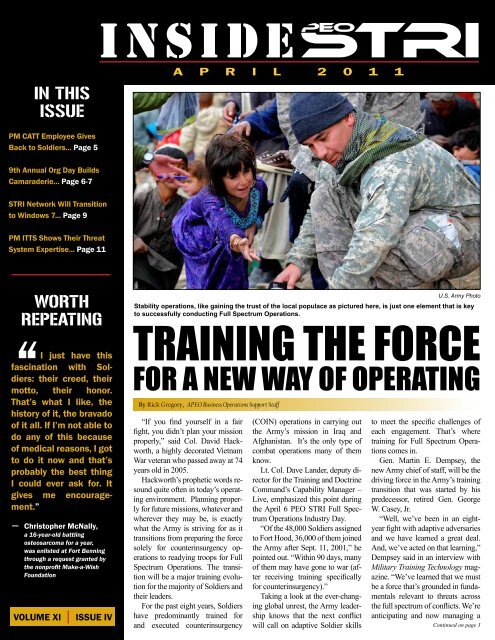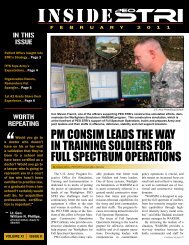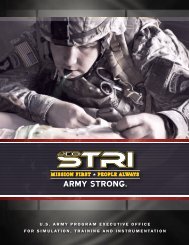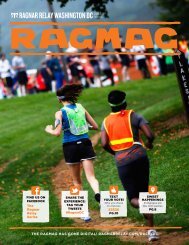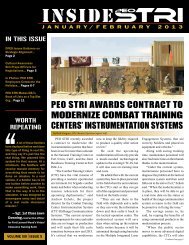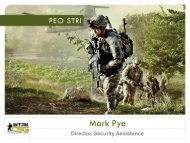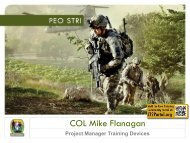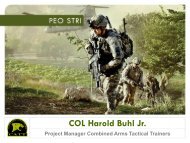InsIde - PEO STRI - U.S. Army
InsIde - PEO STRI - U.S. Army
InsIde - PEO STRI - U.S. Army
You also want an ePaper? Increase the reach of your titles
YUMPU automatically turns print PDFs into web optimized ePapers that Google loves.
Inside<br />
In this<br />
Issue<br />
a p r i l 2 0 1 1<br />
PM CATT Employee Gives<br />
Back to Soldiers... Page 5<br />
9th Annual Org Day Builds<br />
Camaraderie... Page 6-7<br />
<strong>STRI</strong> Network Will Transition<br />
to Windows 7... Page 9<br />
PM ITTS Shows Their Threat<br />
System Expertise... Page 11<br />
Worth<br />
Repeating<br />
I just have this<br />
fascination with Soldiers:<br />
their creed, their<br />
motto, their honor.<br />
That’s what I like, the<br />
history of it, the bravado<br />
of it all. If I’m not able to<br />
do any of this because<br />
of medical reasons, I got<br />
to do it now and that’s<br />
probably the best thing<br />
I could ever ask for. It<br />
gives me encouragement.”<br />
Christopher McNally,<br />
a 16-year-old battling<br />
osteosarcoma for a year,<br />
was enlisted at Fort Benning<br />
through a request granted by<br />
the nonprofit Make-a-Wish<br />
Foundation<br />
VOLUME XI<br />
ISSUE IV<br />
U.S. <strong>Army</strong> Photo<br />
Stability operations, like gaining the trust of the local populace as pictured here, is just one element that is key<br />
to successfully conducting Full Spectrum Operations.<br />
Training the Force<br />
for a New Way of Operating<br />
By Rick Gregory, A<strong>PEO</strong> Business Operations Support Staff<br />
“If you find yourself in a fair<br />
fight, you didn’t plan your mission<br />
properly,” said Col. David Hackworth,<br />
a highly decorated Vietnam<br />
War veteran who passed away at 74<br />
years old in 2005.<br />
Hackworth’s prophetic words resound<br />
quite often in today’s operating<br />
environment. Planning properly<br />
for future missions, whatever and<br />
wherever they may be, is exactly<br />
what the <strong>Army</strong> is striving for as it<br />
transitions from preparing the force<br />
solely for counterinsurgency operations<br />
to readying troops for Full<br />
Spectrum Operations. The transition<br />
will be a major training evolution<br />
for the majority of Soldiers and<br />
their leaders.<br />
For the past eight years, Soldiers<br />
have predominantly trained for<br />
and executed counterinsurgency<br />
(COIN) operations in carrying out<br />
the <strong>Army</strong>’s mission in Iraq and<br />
Afghanistan. It’s the only type of<br />
combat operations many of them<br />
know.<br />
Lt. Col. Dave Lander, deputy director<br />
for the Training and Doctrine<br />
Command’s Capability Manager –<br />
Live, emphasized this point during<br />
the April 6 <strong>PEO</strong> <strong>STRI</strong> Full Spectrum<br />
Operations Industry Day.<br />
“Of the 48,000 Soldiers assigned<br />
to Fort Hood, 36,000 of them joined<br />
the <strong>Army</strong> after Sept. 11, 2001,” he<br />
pointed out. “Within 90 days, many<br />
of them may have gone to war (after<br />
receiving training specifically<br />
for counterinsurgency).”<br />
Taking a look at the ever-changing<br />
global unrest, the <strong>Army</strong> leadership<br />
knows that the next conflict<br />
will call on adaptive Soldier skills<br />
to meet the specific challenges of<br />
each engagement. That’s where<br />
training for Full Spectrum Operations<br />
comes in.<br />
Gen. Martin E. Dempsey, the<br />
new <strong>Army</strong> chief of staff, will be the<br />
driving force in the <strong>Army</strong>’s training<br />
transition that was started by his<br />
predecessor, retired Gen. George<br />
W. Casey, Jr.<br />
“Well, we’ve been in an eightyear<br />
fight with adaptive adversaries<br />
and we have learned a great deal.<br />
And, we’ve acted on that learning,”<br />
Dempsey said in an interview with<br />
Military Training Technology magazine.<br />
“We’ve learned that we must<br />
be a force that’s grounded in fundamentals<br />
relevant to threats across<br />
the full spectrum of conflicts. We’re<br />
anticipating and now managing a<br />
Continued on page 3
General Dempsey Takes Reins<br />
as the New <strong>Army</strong> Chief of Staff<br />
Article Courtesy of the <strong>Army</strong> News Service<br />
Gen. Martin E. Dempsey was<br />
sworn in on April 11 as the new<br />
chief of staff of the <strong>Army</strong>, replacing<br />
Gen. George W. Casey<br />
Jr., who retired this month after<br />
serving as the <strong>Army</strong>’s chief of<br />
staff since April 10, 2007.<br />
Dempsey was previously the<br />
commanding general of the U.S.<br />
<strong>Army</strong> Training and Doctrine<br />
Command at Fort Monroe, Va.<br />
He led TRADOC since December<br />
2008. Before that, he was<br />
the acting commander of U.S.<br />
Central Command, and from<br />
August 2005 to the summer of<br />
2007, he commanded the Multi-<br />
National Security Transition<br />
Command-Iraq.<br />
Dempsey is a 1974 graduate<br />
of West Point where he was<br />
commissioned an armor officer.<br />
During testimony before the<br />
Senate Armed Services Committee<br />
March 3, Dempsey answered<br />
questions about how he<br />
would serve as the next chief of<br />
staff of the <strong>Army</strong>, a position he<br />
I’m honored to be your 37th<br />
chief of staff. I want to assure<br />
you that I’m well aware of the<br />
challenges we face but equally<br />
aware of the opportunities we<br />
will have in the next four years<br />
to do a lot of good both for the<br />
<strong>Army</strong> and for the nation.<br />
My transition team did a<br />
great job helping me “see” our<br />
<strong>Army</strong>, and I want to share two<br />
of their observations:<br />
1. We are really good.<br />
We’ve accomplished everything<br />
that’s been asked of us. Our Soldiers and their families<br />
are proud, courageous and resolute. Our leaders are effective,<br />
engaged and innovative.<br />
2. We are uncertain about the future. The missions in Iraq<br />
and Afghanistan appear to be stabilizing. The nation’s economic<br />
condition appears to be declining. Senior leaders are questioning<br />
our role.<br />
We have been here before, and as I like to tell those who are<br />
interested in our <strong>Army</strong>, “I like the problem we have.” We’ve<br />
never been better organized, better trained or better equipped.<br />
Of course, that’s at least in part because we’ve never been better<br />
resourced. As our resourcing changes, we’ll change, but we’ll be<br />
changing from a position of great strength. That’s why I like the<br />
problem we have.<br />
Over the next few months and in collaboration with our secretary<br />
of the <strong>Army</strong>, I’ll share some thoughts with you about the<br />
role of our <strong>Army</strong>, how we will remain adaptable, how our Ac-<br />
was nominated for in January by<br />
President Barack Obama.<br />
“I sit before you today with<br />
confidence that whatever challenges<br />
confront us in the future,<br />
your <strong>Army</strong> will respond with the<br />
same courage and resolve that<br />
has characterized it for the past<br />
235 years,” Dempsey said.<br />
He told senators that he will<br />
work hard every day as chief of<br />
staff to earn the trust of Soldiers<br />
by ensuring they have what they<br />
need.<br />
“I will work to match their<br />
drive, their sacrifice and their<br />
resolve,” Dempsey said, “and I<br />
will partner with the Congress<br />
of the United States of America<br />
and this committee in particular,<br />
to ensure we remain worthy of<br />
the title ‘America’s <strong>Army</strong>.’”<br />
Lt. Gen. Robert Cone, commander<br />
of III Corps and Fort<br />
Hood, Texas, has been nominated<br />
to take over for Dempsey as<br />
commander of TRADOC.<br />
•<br />
A Note from the Chief<br />
tive and Reserve components will contribute to maintaining our<br />
position as the nation’s decisive land force, and how we will remain<br />
the nation’s preeminent leadership experience.<br />
The “talk on the street” is all about how resource constraints<br />
are coming and about how we must act to ensure a “soft landing.”<br />
You won’t hear that from me. I didn’t take the job as your<br />
37th chief of staff to orchestrate a “soft landing.” I took the job<br />
as the 37th to team with an incredible group of senior military<br />
and civilian leaders to make our <strong>Army</strong> smarter, better and more<br />
capable—with the resources we are given—so that we provide<br />
the nation with the greatest number of options for an uncertain<br />
future.<br />
We remain an <strong>Army</strong> at war. We will provide whatever it<br />
takes to achieve our objectives in the current fights. We will<br />
keep faith with our families and with our wounded.<br />
One other thing you need to know about me—in my 37 years,<br />
I’ve been deployed several times to several different kinds of<br />
conflict. In each case upon notification to deploy, I was able to<br />
requisition nearly everything my unit needed. What I couldn’t<br />
requisition was trust, discipline and fitness. These qualities<br />
have to exist in every unit and in every Soldier of our <strong>Army</strong> all<br />
the time. When I come to visit your organization—whether a<br />
tactical formation or part of our institutional <strong>Army</strong>—I’ll want<br />
to know what you’re doing to develop a climate of trust, to ensure<br />
the discipline of your Soldiers and to increase the fitness of<br />
the force.<br />
I’m proud to serve with you.<br />
Martin E. Dempsey<br />
37th Chief of Staff<br />
2<br />
Inside <strong>STRI</strong> april 2011
Full Spectrum Operations: continued from cover<br />
transition for our <strong>Army</strong> that must be<br />
better prepared for Full Spectrum<br />
Operations in an era of persistent<br />
conflict against hybrid threats and<br />
uncertain future challenges.”<br />
Those lessons have been incorporated<br />
into the recently updated<br />
<strong>Army</strong> doctrine, Field Manual 3-0,<br />
which details the specifics for carrying<br />
out Full Spectrum Operations.<br />
FM 3-0 defines Full Spectrum<br />
Operations as when the “<strong>Army</strong><br />
forces combine offensive, defensive,<br />
and stability or civil support<br />
operations simultaneously as part<br />
of an interdependent joint force to<br />
seize, retain and exploit the initiative,<br />
accepting prudent risk to create<br />
opportunities to achieve decisive<br />
results.”<br />
As an example, offensive operations<br />
will be used to dislocate,<br />
isolate, disrupt and destroy enemy<br />
forces while seizing key terrain to<br />
create a secure environment for<br />
stability operations. Defensive operations,<br />
on the other hand, will be<br />
used to deter or defeat enemy offensive<br />
operations so as to retain key<br />
terrain and protect the populace,<br />
critical assets and the infrastructure.<br />
As learned in Iraq and Afghanistan,<br />
critical skills will be needed to<br />
provide stability operations geared<br />
toward providing a secure environment<br />
that will meet the needs of the<br />
populace and gain support for the<br />
host-nation government.<br />
Simply put, the individual mission<br />
will determine the weight<br />
each effort is given. “During major<br />
combat operations, a division<br />
may attack in one area, defend in<br />
another and focus on stability tasks<br />
in a third. Offensive and defensive<br />
operations may be complemented<br />
with stability tasks and vice versa at<br />
any point of a campaign,” the operations<br />
field manual states.<br />
For the home front, Full Spectrum<br />
Operations training will focus<br />
on civil support to restore essential<br />
services, maintain or restore law<br />
and order, protect infrastructure and<br />
property or maintain or restore local<br />
government during domestic disasters<br />
such as hurricanes, earthquakes<br />
or civil disturbances.<br />
Dempsey said the key to Full<br />
Spectrum Operations is the <strong>Army</strong><br />
being able to “simultaneously conduct<br />
offense, defense and stability<br />
operations and to react to all forms<br />
of contact. When the unexpected<br />
occurs, good leaders will innovate<br />
and adapt. And their units, if<br />
grounded and extremely proficient<br />
in a select number of tasks, can and<br />
will adapt as well.”<br />
Secretary of the <strong>Army</strong> John<br />
McHugh, when recently speaking<br />
before Congress on the posture of<br />
the U.S. <strong>Army</strong>, stressed the importance<br />
of transitioning from COIN to<br />
Full Spectrum Operations.<br />
“We remain in an era of persistent<br />
conflict facing an uncertain and<br />
increasingly complex strategic environment.<br />
Hybrid threats made up<br />
of conventional, irregular, criminal<br />
and terrorist capabilities will continue<br />
to test our forces,” he reported.<br />
“These threats will avoid our<br />
strengths and attack us asymmetrically.<br />
Therefore, we must continue<br />
to organize our formations, update<br />
our doctrine and prepare our forces<br />
for the full spectrum of operations.<br />
“As we continue to build dwell<br />
and increase the time Soldiers have<br />
at home, more units will conduct<br />
full spectrum training rotations<br />
at the Combat Training Centers<br />
increasing our ability to hedge<br />
against the unexpected and restoring<br />
strategic flexibility to the force,”<br />
McHugh added.<br />
Dempsey said he strongly believes<br />
virtual and constructive training<br />
needs to be strategically woven<br />
into the learning requirements inherent<br />
in the move to Full Spectrum<br />
Operations.<br />
“The era of the sage on the stage<br />
bludgeoning a student population<br />
with PowerPoint is over, so we<br />
better figure out how to enrich our<br />
Soldiers’ learning experiences in<br />
a way that challenges them and is<br />
consistent with who they are and<br />
what they expect,” he said. “The<br />
challenge is to leverage the value<br />
of virtual, constructive and gaming<br />
environments so we don’t disenfranchise<br />
them by applying stale or<br />
outdated learning models.”<br />
Dempsey cautioned, though, that<br />
training needs to be a well thought<br />
out blend of technology and live,<br />
hands-on experiences.<br />
“We cannot become so enamored<br />
with technology that we lose<br />
sight of the importance of live training<br />
experiences where physical<br />
and interpersonal skills are honed<br />
through direct feedback from quality<br />
facilitators,” he explained. “The<br />
challenge is to use virtual, constructive,<br />
gaming and distributed learning<br />
technologies where they will<br />
have the greatest impact in taking<br />
our Soldiers from novice to expert<br />
at the point in time where learning<br />
is needed.”<br />
Hackworth would probably<br />
stand and salute those sentiments.<br />
“That’s what supporting the<br />
troops is really all about—making<br />
sure American grunts get the right<br />
stuff,” Hackworth once said. The<br />
tenets of Full Spectrum Operations<br />
will ensure today’s Soldier gets the<br />
right stuff.<br />
<strong>STRI</strong> IBIds Farewell to HR Director<br />
U.S. <strong>Army</strong> Photo/Doug Schaub<br />
Program Executive Officer Dr. Jim Blake presented <strong>PEO</strong> <strong>STRI</strong>’s former Personnel Resources Manager Mae<br />
Hazelton with the Career Service Award during her retirement ceremony April 7. The ceremony, held in<br />
Partnership III, marked 30 years of government service for Hazelton. Among her contributions to <strong>PEO</strong> <strong>STRI</strong>,<br />
Hazelton reduced the average personnel action processing time from 55 days to 27 days, resulting in a<br />
Department of Defense allocation of $1.9 million to support near and long-term personnel management<br />
requirements. For her many contributions to the organization, Blake also presented Hazelton with the<br />
Meritorious Civilian Service Award during the ceremony. Lisa Taylor, the new personnel resources manager,<br />
reported to <strong>PEO</strong> <strong>STRI</strong> April 25.<br />
Inside <strong>STRI</strong> april 2011<br />
3
PM ITTS Conducts Integrated Threat Force Demo<br />
By William Bonner, PM ITTS Project Director<br />
PM ITTS’ Threat Systems<br />
Management Office (TSMO),<br />
along with its supporting industry<br />
partners, conducted a successful<br />
Initial Operational Capability<br />
(IOC) demonstration of<br />
the Integrated Threat Force (ITF)<br />
Jan. 20 at Redstone Arsenal, Ala.<br />
“The ITF demo was a great<br />
success. It gave us our first<br />
glimpse of the true value that<br />
ITF brings to the table for the test<br />
community’s major test events,”<br />
Col. Mike Zarbo, PM ITTS’<br />
leader, said after attending the<br />
demonstration. Rob Reyenga,<br />
<strong>PEO</strong> <strong>STRI</strong>’s deputy program executive<br />
officer, and Mark Tutten,<br />
the director of TSMO, also attended<br />
the test event.<br />
TSMO manages the <strong>Army</strong>’s<br />
total life cycle of threat systems<br />
for testing in the live, virtual and<br />
constructive environments. As<br />
a result, the office supports the<br />
entire Department of Defense to<br />
include the intelligence community,<br />
and international partners.<br />
The IOC event was an integrated<br />
and collaborative threat<br />
system demonstration held in<br />
collaboration with some of PM<br />
ITTS’ industry partners. “I’m<br />
extremely impressed with the<br />
great job and partnership between<br />
the TSMO team and industry<br />
in fielding this capability<br />
to the <strong>Army</strong>,” Zarbo noted. “The<br />
demonstration was a resounding<br />
success and shows the increased<br />
TSMO capability available to<br />
customers in the test and evaluation<br />
community.”<br />
ITF provides the <strong>Army</strong> Test<br />
and Evaluation Command<br />
(ATEC) a scalable threat force<br />
against which U.S. military systems<br />
and system-of-systems are<br />
tested during their operational<br />
evaluation events. The ITF is<br />
adaptable and provides a comprehensive<br />
threat capability by<br />
employing intelligence community<br />
approved tactics, techniques<br />
and procedures combined with<br />
threat faithful systems representative<br />
of potential opposing<br />
forces.<br />
“I look at the ITF as the mother<br />
ship for a threat common operating<br />
picture with command,<br />
control, communications, computers<br />
and intelligence of an integrated<br />
realistic <strong>Army</strong> threat force<br />
under one live, virtual and constructive<br />
umbrella. The ITF is<br />
invaluable to test officers for test<br />
planning, execution and analysis<br />
and is one of ATEC’s highest priorities<br />
within PM ITTS,” Zarbo<br />
acknowledged.<br />
The IOC demonstration consisted<br />
of 11 mock-threat test vignettes<br />
focused on demonstrating<br />
the integration, collaboration,<br />
visualization and Command,<br />
Control and Communications<br />
(C3) of the ITF with four of its<br />
threat systems. The scenarios<br />
exercised the test and evaluation<br />
processes and test event flow by<br />
demonstrating the four phases of<br />
the operational testing process:<br />
strategic planning, operational<br />
preparation, tactical execution,<br />
and after-action review and analysis.<br />
During the strategic planning<br />
phase, the ITF demonstrated its<br />
power to leverage collaboration<br />
tools and processes to streamline<br />
initial planning for threat deployment,<br />
identify gaps in test plans<br />
and outline the threat operational<br />
orders needed to support testing.<br />
The ITF successfully demonstrated<br />
the ability to provide this<br />
unique support across live, virtual<br />
and constructive test entities.<br />
Next, during the operational<br />
preparation phase, the ITF used<br />
command and control applications<br />
to develop and deliver operational<br />
orders via threat faithful<br />
communications to the ITF<br />
threat systems.<br />
Upon receipt of the operational<br />
orders during the tactical<br />
execution phase, the threat<br />
electronic warfare and threat<br />
computer network operations<br />
An Early Fall for <strong>PEO</strong> <strong>STRI</strong><br />
Continued on page 11<br />
Courtesy Photo/Scott Pulford<br />
The torrential downpour and gusting winds March 30 forced a large tree down in front of the<br />
Annex building. The tree fell around 5 p.m., blocking all of those wanting to exit the parking lot<br />
stuck in place. A forklift came to remove the planters around the Annex building so people could<br />
exit through the roundabout driveway.<br />
4<br />
Inside <strong>STRI</strong> april 2011
By Megan Jeffers, <strong>PEO</strong> <strong>STRI</strong> External Affairs Specialist<br />
Benefits Wounded<br />
Warriors<br />
While watching the “The Bravest<br />
Families in America” episode<br />
of the Oprah Winfrey Show with<br />
his wife, José García-Aponte of<br />
PM CATT had his own aha moment.<br />
Having been mulling for<br />
months over a way to honor our<br />
Soldiers and their sacrifices, it was<br />
during Oprah’s show that García-<br />
Aponte found his answer.<br />
“It just struck me,” he said.<br />
“My wife and I had been looking<br />
for a way to raise awareness for<br />
our armed forces members who<br />
either gave their life or came back<br />
severely injured. This was just a<br />
perfect way to recognize that sacrifice.”<br />
At the time “The Bravest<br />
Families…” episode aired, García-Aponte,<br />
a retired command<br />
sergeant major, and his wife had<br />
a family member away at war,<br />
making them a Blue Star family.<br />
Understanding the hardships our<br />
Warfighters often face, García-<br />
Aponte and his wife came up with<br />
the idea to start an organization<br />
aimed to help those wounded in<br />
action and their families.<br />
Dubbed Operation Giveback,<br />
the organization, which is currently<br />
under the umbrella of the nonprofit<br />
Association of the United<br />
States <strong>Army</strong>, plans to host fundraising<br />
events with all proceeds<br />
going to fellow organizations<br />
aimed at supporting service men<br />
and women injured in war.<br />
“The inaugural event will be<br />
a Walk.Run.Roll 5K/10K held at<br />
the University of Central Florida’s<br />
Veterans Memorial,” García-<br />
Aponte said. “Proceeds will go to<br />
fund the Wounded Warrior Project.”<br />
Also a nonprofit organization,<br />
the Wounded Warrior Project is<br />
headquartered in Jacksonville,<br />
Fla., and is dedicated to raising<br />
awareness of our injured service<br />
members and their needs.<br />
The money raised from the road<br />
race, which will be held Saturday,<br />
May 14, at 7 a.m., is not just to<br />
support the <strong>Army</strong>, García -Aponte<br />
said. “It will support Warfighters<br />
from all services.<br />
“I’ve noticed there are so many<br />
people who want to do something<br />
to help our Soldiers, but they don’t<br />
know what do,” he said. “And if<br />
we don’t help, then who? If we<br />
don’t help now, then when?”<br />
Since the event is a walk, run<br />
and roll road race, those in wheelchairs<br />
and families with young<br />
children requiring strollers are encouraged<br />
to participate.<br />
There will be several wounded<br />
warriors with varying injuries<br />
present at the event who are unable<br />
to run in the race, García-Aponte<br />
said. “That’s why we added the<br />
‘roll.’”<br />
For participants who register<br />
before May 7, the cost for the 5K<br />
is $25, while participation in the<br />
10K is $40. From May 7-13, the<br />
cost is $30 and $45,<br />
respectively, while<br />
day-of registration<br />
is $35 and $50, respectively.<br />
Cost<br />
for participants 18<br />
years and under is<br />
$20 for either race<br />
and $25 on race day.<br />
All walkers, runners<br />
and rollers will<br />
receive a jersey T-<br />
shirt for their participation.<br />
Running<br />
Zone, a company<br />
from Melbourne,<br />
Fla., has been hired<br />
to time the races.<br />
Awards for top finishers<br />
will be given<br />
out after the race.<br />
When the 5K and 10K are<br />
complete, there will also be a kids’<br />
fun run, García-Aponte said. The<br />
“Warrior Kids” race for children<br />
ages 10 and under is $5 and will<br />
only be a short distance.<br />
Monetary donations and volunteers<br />
are welcome, García-Aponte<br />
added. “For those who cannot<br />
physically participate in the race,<br />
we need people to help with both<br />
the set up and dismantling of the<br />
event.”<br />
Proceeds from the race will be<br />
posted online to provide transparency,<br />
García-Aponte said. This is a<br />
volunteer effort, he added, and we<br />
want the public to know that their<br />
money is going to a worthy cause.<br />
One person who personally<br />
recognizes the value of such a<br />
cause is retired <strong>Army</strong> Sgt. Noé<br />
Santos Diloné.<br />
A wounded warrior himself,<br />
Santos Diloné lost his left leg in<br />
2005 when an IED blew up while<br />
he was in his vehicle near Taji,<br />
Iraq.<br />
He has since become involved<br />
in events such as the University of<br />
Central Florida’s baseball game<br />
for Military Appreciation Night<br />
on April 30, and said that for him,<br />
participating in events that support<br />
our wounded warriors, such<br />
as walking in the Walk.Run.Roll<br />
event, is a “no-brainer.”<br />
“I love and support the troops<br />
and wounded warriors, so I immediately<br />
made up my mind that<br />
I was going to walk it,” he said. “I<br />
just want our community to know<br />
how many Soldiers, wounded or<br />
not, live in our community and<br />
how many of them have sacrificed<br />
either time and/or limbs for our<br />
country.<br />
“A simple ‘thank you’ might<br />
make one of these Soldier’s day a<br />
whole lot better,” he said.<br />
“We are still a country at war,”<br />
García-Aponte added. “And it’s<br />
important for people to recognize<br />
that.”<br />
For more information on Operation<br />
Giveback or to sign up<br />
for the Walk.Run.Roll event, visit<br />
www.operation-giveback.com.<br />
Inside <strong>STRI</strong> april 2011<br />
Courtesy Photo<br />
Wounded warrior and retired <strong>Army</strong> Sgt. Noé Santos Diloné stands with<br />
University of Central Florida (UCF) ROTC cadets at the Central Florida<br />
Navy League’s Wounded Warrior Lone Sailor 5K March 19 in Baldwin Park.<br />
Santos Diloné, who lost his left leg during a 2005 IED explosion in Iraq, will<br />
also walk in the Operation Giveback race May 14 at UCF.<br />
5
Annual OrgDay<br />
April 8, 2011<br />
Red Bug Lake Park<br />
6<br />
Inside <strong>STRI</strong> april 2011
Congrats PM TRADE<br />
for winning 1st place!<br />
Inside <strong>STRI</strong> april 2011<br />
7
The Engagement Skills Trainer Goes Mobile<br />
By Lt. Col. Jay Smith, <strong>PEO</strong> <strong>STRI</strong>’s <strong>Army</strong> National Guard Advisor<br />
PM CATT’s Product Manager for Ground Combat Tactical Trainers<br />
(PM GCTT) is following up its successful initial fielding of the Engagement<br />
Skills Trainer 2000 (EST 2000) with a mobile “proof-of-principle”<br />
effort, specifically designed for the <strong>Army</strong> National Guard, <strong>Army</strong> Reserve<br />
and Reserve Officers’ Training Corps.<br />
The idea is simple: mount a five-lane EST 2000 on a mobile, self-powered<br />
semi-trailer and bring it to remote armories and readiness centers to<br />
support weekend battle assembly training. The mobile EST 2000 will<br />
also come with an instructor/operator who will ensure the system is set<br />
up to meet the unit’s training plans before the battle assembly starts and<br />
will then transport the system to its next scheduled location.<br />
The EST 2000 has three modes of training: marksmanship, collective<br />
tasks and judgmental use of force. This provides Soldiers an opportunity<br />
to practice with their weapons individually and as a team.<br />
Lt. Col. Charles Stein, who oversees PM GCTT, said, “We’re looking<br />
forward to jump-starting this proof-of-principle initiative. It’s based<br />
on the old saying in the Reserves, ‘Bring the training to the troops, not<br />
troops to training.’<br />
“The whole idea is to provide this simulator to units that currently<br />
don’t have EST 2000s, and allow them to accomplish training objectives<br />
that they’d normally have to drive for several hours to accomplish,” he<br />
continued.<br />
Stein initially observed a mobile EST 2000 being used by the Israeli<br />
Defense Forces, who are heavily reserve-based, and said he was impressed<br />
by what he saw. “Even though Israel is a relatively small country,<br />
they value the efficiency of not having to relocate entire units to train<br />
on a system they don’t normally have at their local reserve centers.”<br />
Conference Gets the Word Out About Gaming<br />
By Megan Jeffers, <strong>PEO</strong> <strong>STRI</strong> External Affairs Specialist<br />
The proof-of-principle is an experiment to document the viability and<br />
versatility of making these kinds of big, complex simulators mobile. The<br />
U.S. Military Academy’s engineering psychology program is assisting<br />
PM GCTT by helping to collect and collate training statistics and document<br />
the usefulness of the mobile EST 2000. The first mobile EST 2000<br />
will be based in the central U.S. starting May 2011, and will be available<br />
to Guard, Reserve and ROTC units in Arkansas, Oklahoma, Missouri,<br />
Kansas, Iowa and Illinois.<br />
For more information on the mobile EST 2000, call the PM GCTT<br />
<strong>Army</strong> National Guard advisor at 407-384-5116 or 407-384-5139.<br />
U.S. <strong>Army</strong> Photo/Doug Schaub<br />
PM CATT oversees the production, fielding and sustainment of the<br />
Engagement Skills Trainer (EST) 2000. The EST 2000 enables Soldiers to<br />
go through initial and sustainment marksmanship training.<br />
The boom of the gaming industry<br />
was well recognized at the<br />
fourth annual Defense GameTech<br />
Users’ Conference, held March<br />
22-25 at Orlando’s Caribe Royale<br />
Hotel.<br />
Setting an all-time attendance<br />
8<br />
Inside <strong>STRI</strong> april 2011<br />
record of 776 participants,<br />
this year’s conference<br />
highlighted the<br />
advancements of gaming<br />
technology within<br />
the Department of<br />
Defense and drew attendees<br />
from across the<br />
globe.<br />
“The conference<br />
has shown continued<br />
growth and exceeded<br />
every metric we put out<br />
for ourselves in terms<br />
of attendance,” Pete<br />
Marion, assistant program<br />
executive officer for <strong>PEO</strong><br />
<strong>STRI</strong>’s Customer Support Group,<br />
said.<br />
Held in conjunction with the<br />
<strong>Army</strong> Games for Training Conference,<br />
the week focused on virtual<br />
worlds and gaming technologies<br />
and how they enhance training<br />
for our Warfighters by providing<br />
simulated exercises and battle scenarios.<br />
The conference, which was<br />
hosted by Team Orlando, conveyed<br />
the evolution of gaming<br />
technology and its associated applications,<br />
citing that the systems<br />
may be tailored to the individual<br />
user and that much of the technology<br />
re-creates and reflects specific<br />
circumstances our Warfighters<br />
may encounter while in theater.<br />
With a showroom floor of exhibit<br />
booths representing 70 different<br />
companies, GameTech<br />
participants also attended presentations,<br />
panels and tutorials, and<br />
saw firsthand the gaming and virtual<br />
world systems with which our<br />
Soldiers interact and train.<br />
The conference’s four keynote<br />
speakers were also a big draw for<br />
GameTech registrants.<br />
Lt. Gen. Michael A. Vane, deputy<br />
commanding general for Futures<br />
and the director of the <strong>Army</strong><br />
Capabilities Integration Center at<br />
the Training and Doctrine Command,<br />
focused on the importance<br />
of training the joint force in which<br />
Warfighters at all levels are engaged<br />
in the training process. He<br />
stressed that gaming technologies<br />
were a key tool in creating this dynamic.<br />
Another <strong>Army</strong> general, Brig.<br />
Gen. Harold J. Greene, deputy<br />
commanding general for the U.S.<br />
<strong>Army</strong> Research, Development and<br />
Engineering Command, spoke to<br />
the audience about the importance<br />
of forums such as GameTech and<br />
how they provide an opportunity<br />
Continued on page 12
Windows 7 is Coming<br />
to a Computer Near You!<br />
By Kristen A. McCullough, <strong>PEO</strong> <strong>STRI</strong> Public Affairs Officer<br />
The <strong>PEO</strong> <strong>STRI</strong> Corporate Information<br />
Office (CIO) is transitioning<br />
the organization’s computer<br />
operating systems April 21 to May<br />
31 from Windows XP to Windows<br />
7 as mandated by the <strong>Army</strong>. The<br />
transition is occurring to ensure<br />
<strong>PEO</strong> <strong>STRI</strong> meets the latest computer<br />
security requirements and<br />
postures the organization for future<br />
<strong>Army</strong> initiatives, like enterprise<br />
email and incorporation into<br />
a single domain network.<br />
“When your computer is migrated<br />
from Windows XP to Windows<br />
7, you will move up to the<br />
latest, most easy-to-use and most<br />
stable Windows operating system<br />
available,” Tom Petrillo, <strong>PEO</strong><br />
<strong>STRI</strong>’s deputy CIO, said. “As<br />
with any upgrade, there remains<br />
the possibility that minor disruptions<br />
will occur. We are planning<br />
the rollout in a way that minimizes<br />
downtime and eases the transition<br />
for everyone.”<br />
Employees—all of whom<br />
will migrate to Windows 7 in a<br />
grouped, systematic fashion—will<br />
receive several email notifications<br />
of their scheduled transition date.<br />
The first email will go out 14 days<br />
before the move, then seven days<br />
out, and finally the day before the<br />
actual migration.<br />
Some action is required from<br />
each <strong>PEO</strong> <strong>STRI</strong> employee to ensure<br />
the transition between operating<br />
systems appears seamless.<br />
First, all users who encrypt data<br />
on their computers must decrypt<br />
the data otherwise the information<br />
will be lost.<br />
Second, all desktop and laptop<br />
computers on the <strong>PEO</strong> <strong>STRI</strong><br />
network should remain on during<br />
non-duty hours because the migration<br />
will occur overnight. Employees<br />
should either log off or restart<br />
their computers, but they should<br />
not shut down their system.<br />
If the equipment will be out of<br />
the office in the event the employee<br />
is on travel or on leave, the user<br />
must notify the Help Desk at 407-<br />
380-4832 before their scheduled<br />
migration date to arrange a later<br />
time to transition to Windows 7.<br />
The CIO technical staffers have<br />
developed an application that will<br />
automatically transfer data on<br />
every employee’s computer, like<br />
“My Documents,”<br />
“Favorites,” “Desktop”<br />
and others. If<br />
employees have any<br />
other files they would<br />
like saved, they<br />
should transfer them<br />
to their assigned network<br />
drive.<br />
Once Windows 7<br />
is loaded, employees<br />
must adhere to a<br />
new login procedure.<br />
They must press<br />
Ctrl+Alt+Delete and<br />
then click “Switch<br />
Credentials” to get to<br />
the CAC card input<br />
screen.<br />
CIO senior leaders<br />
said they encourage<br />
employees to review<br />
Windows 7 training<br />
guides. Windows 7<br />
training videos that<br />
demonstrate some of<br />
the basic features of<br />
the operating system<br />
are available on the<br />
Windows 7 Migration<br />
SharePoint portal<br />
located at https://<br />
portal.peostri.army.<br />
mil/sites/windows7/.<br />
A Windows 7<br />
Quick Reference<br />
sheet will be distributed<br />
to each mi-<br />
grated user, and can also be found<br />
at https://portal.peostri.army.mil/<br />
sites/windows7/.<br />
In addition to the Windows 7<br />
Quick Reference sheet, a Quick<br />
Reference Guide will be distributed<br />
to each migrated user, and can<br />
be found at https://portal.peostri.<br />
army.mil/sites/windows7/.<br />
The SharePoint site also has<br />
a discussion thread, much like a<br />
blog, for employees to send ques-<br />
tions, share lessons learned and<br />
provide feedback to the CIO on<br />
their transition experience.<br />
For technical support with computer<br />
issues due to the Windows 7<br />
migration, contact the Help Desk<br />
at 407-380-4832. Questions concerning<br />
Windows 7 migration requirements<br />
and policies should be<br />
directed to Tom Petrillo at 407-<br />
208-3367 or thomas.petrillo@<br />
us.army.mil.<br />
<strong>PEO</strong> <strong>STRI</strong>’s Sgt. Maj. Pat Ogden will host a FREE three day<br />
Self-Defense<br />
Seminar<br />
May 2-4<br />
12 p.m. to 1 p.m.<br />
at the outdoor basketball courts located by<br />
the deFlorez building<br />
The three-day class is designed to teach women and<br />
men survival tactics in the event they are attacked.<br />
To register, send your name, office code and<br />
phone number to SHAPE@peostri.army.mil.<br />
This is a SHAPE sponsored event.<br />
All military, civilian and in-house support contractors are welcome to attend.<br />
Inside <strong>STRI</strong> april 2011<br />
9
Citizen<br />
stri<br />
“What was your favorite part of<br />
<strong>PEO</strong> <strong>STRI</strong>’s ninth annual Org Day?”<br />
“I selected to sing ‘Letters From Home’<br />
during <strong>STRI</strong> Idol. I know Soldiers can’t have<br />
beards, so shortly before <strong>STRI</strong> Idol, I snuck<br />
away and completely shaved for the first time<br />
since 1988. I enjoyed performing, and for a<br />
moment, representing the Soldier who is in<br />
harm’s way.”<br />
- Chris Catotti, PM TRADE<br />
“When I arrive at 6:30 a.m. at the peacefully<br />
empty park and watch it transform with that<br />
rush of energy. It’s <strong>PEO</strong> <strong>STRI</strong>’s workforce<br />
demonstrating in mass the teamwork values<br />
that make it the world class organization that<br />
it is.”<br />
- Walt Pezzolo, BOO<br />
“My favorite part of Org Day had to be the<br />
Acquisition Center’s rendition of Purple<br />
Rain. A piece of artistry like that on YouTube<br />
would get a million hits.”<br />
- Randy Edney, <strong>PEO</strong> Staff<br />
“The Extreme Engineering event was my<br />
favorite. I was responsible for one corner<br />
of the tent and remember seeing this large<br />
team, with all of our management offices<br />
represented, working frantically together and<br />
having great fun doing it.”<br />
- Jerry Sirmans, PM ITTS<br />
“My favorite part of Org Day was the fact<br />
that everyone that said they were going to<br />
help me with the food prep and service DID!<br />
Providing food to more than 700 people is<br />
a very hard job and it could not have been<br />
accomplished without the help and support of<br />
a great team.”<br />
- Toni Fiorenza, CSG<br />
“I liked <strong>STRI</strong> Idol. It lets you see the<br />
creativity of the team!”<br />
- Sgt. Maj. Pat Ogden, <strong>PEO</strong> Staff<br />
“It was definitely watching Mr. Joe Giunta’s<br />
defeated face as we ran the Acquisition<br />
Center team off the volleyball court. Sweet!”<br />
- LTC(P) Gordon Graham, PM TRADE<br />
Want your opinion heard? Answer May’s Question! The question is open to the entire workforce.<br />
“Summer’s right around the corner! What’s your best piece of summer safety advice?”<br />
Send your response to Kristen.McCullough@us.army.mil and put Citizen <strong>STRI</strong> in the subject line.<br />
10<br />
Inside <strong>STRI</strong> april 2011
Threat Demo Force: continued from pg 4<br />
systems executed their missions.<br />
At this time, the threat computer<br />
network operations toolset conducted<br />
computer network exploitation<br />
and computer network<br />
attack missions on representative<br />
blue force wired and wireless targets.<br />
Concurrently, threat signals<br />
intelligence and direction finding<br />
systems conducted electronic<br />
support using signal intercept and<br />
direction finding to provide target<br />
data to the ITF for situational<br />
awareness and visualization, and<br />
direct follow-on jamming of blue<br />
command and control networks.<br />
Also, the constructive threat<br />
electronic attack system provided<br />
visualization and constructive<br />
jamming of blue receivers within<br />
OneSAF as directed by the ITF<br />
C3 systems.<br />
Using its 9C2 command and<br />
control software interface, the<br />
ITF directed the threat electronic<br />
attack systems in jamming missions<br />
against blue force tactical<br />
radios.<br />
Throughout each phase, the<br />
ITF provided a system-of-systems,<br />
real-time visualization for<br />
a collaborative command and<br />
control common operating picture.<br />
During the last phase, the<br />
ITF demonstrated its test and<br />
evaluation after-action review<br />
The ITF, with its integrated threat systems, brings the power of scalability to <strong>Army</strong> testing by representing multiple<br />
levels of threat Command, Control and Communications (C3). The ITF’s C3 suite includes a threat higher headquarters<br />
vehicle for threat liaison to test control, while the command post vehicles, tactical command vehicles, tactical network<br />
vehicle and global systems mobile trailers provide the scalable C3.<br />
and analysis capability by displaying<br />
collected test event data<br />
and initial data analysis, and<br />
made it readily available for inclusion<br />
into test reports and follow-on<br />
evaluations.<br />
“Although built to fulfill a test<br />
community requirement, the ITF<br />
design incorporating live, virtual<br />
and constructive environments<br />
makes it compatible with existing<br />
distributed training systems.<br />
U.S. <strong>Army</strong> Photo/PM ITTS<br />
The ITF system’s mobility, integrated<br />
mission planning capabilities,<br />
data capture and playback<br />
makes it ideal to support future<br />
distributed training scenarios,”<br />
Tutten emphasized.<br />
Tip of the Month<br />
By Marge Hadbavny, Protocol Officer<br />
A Hint About<br />
a U.S. Soldier's<br />
Uniform<br />
“U.S. <strong>Army</strong>” is worn on a<br />
Soldier’s uniform over his or<br />
her heart signifying loyalty.<br />
His or her name is worn<br />
opposite “U.S. <strong>Army</strong>” so it’s<br />
easily in eye view, especially<br />
when shaking hands.<br />
HOLIDAYS<br />
Events<br />
Mother’s Day..........................May 8<br />
Operation Giveback Race.......May 14<br />
Town Hall Meeting.................May 17<br />
Armed Forces Day..................May 21<br />
Memorial Day.........................May 30<br />
Inside<br />
Inside <strong>STRI</strong> is an authorized publication for military and<br />
civilian members of the U.S. <strong>Army</strong> Program Executive Office for<br />
Simulation, Training and Instrumentation, Orlando, Fla. 32826.<br />
Inside <strong>STRI</strong> is published under the authority of AR 360-1 and<br />
applies the Associated Press Stylebook industry standard.<br />
Contents of Inside <strong>STRI</strong> are not necessarily the official<br />
views of, or endorsed by, the U.S. Government, Department of<br />
Defense, Department of the <strong>Army</strong>, or <strong>PEO</strong> <strong>STRI</strong>.<br />
Editorial material for publication should be submitted<br />
to <strong>PEO</strong> <strong>STRI</strong> Public Affairs Office, 12350 Research Parkway,<br />
Orlando, Fla. 32826. The PAO reserves the right to edit all<br />
material submitted for publication.<br />
For more information about <strong>PEO</strong> <strong>STRI</strong> or to view Inside <strong>STRI</strong><br />
online, visit our website at www.peostri.army.mil<br />
Editor:<br />
Kristen Dooley McCullough<br />
Editor-in-Chief<br />
Kristen.McCullough@us.army.mil<br />
Design:<br />
Dwain Fletcher Co.<br />
CGgraphics@us.army.mil<br />
Inside <strong>STRI</strong> april 2011<br />
11
Gametech: continued from pg 8<br />
for dialog and the development of ideas. He said that gaming<br />
provides our Warfighters with an engaging way to achieve necessary<br />
training.<br />
Meanwhile, Mark Long, chief executive officer of Zombie<br />
Studios, reflected on the importance of transmedia, citing that<br />
imagination and cross-media interaction is key to pushing the<br />
fictional world in a new direction.<br />
Expanding on the success of the gaming industry, David A.<br />
Smith, chief innovation officer at Lockheed Martin Global Training<br />
and Logistics, espoused the benefits of three-dimensional<br />
technology and its interactive capabilities.<br />
With the development of serious games and virtual worlds on<br />
the rise, this generation of Soldiers that grew up texting and gaming<br />
is well-versed in instantaneous, interactive communication.<br />
While virtual worlds, such as Second Life, extend gaming to a<br />
greater number of users, the tailored scenarios and instantaneous<br />
results reflected in today’s gaming technology provide Warfighters<br />
an additional level of training unavailable a generation ago.<br />
The real-world training displayed during GameTech offered<br />
insight to where gaming is and the endless possibilities of where<br />
it could go.<br />
With another successful conference under his belt, Marion<br />
summed up the event by saying, “This has been a really great<br />
year, and as we bring in more expertise from around the county,<br />
it will only get better.”<br />
Team Orlando<br />
in Photos<br />
U.S. <strong>Army</strong> Photo/Doug Schaub<br />
Jim Crabtree (right), <strong>PEO</strong> <strong>STRI</strong>’s technical lead for the planning<br />
and execution of testing for PM FFS’ Brigade Combat Team<br />
Modernization products, retired March 31. The ceremony, held in<br />
Partnership III, was officiated by the Joe Giunta, the director of<br />
<strong>PEO</strong> <strong>STRI</strong>’s Acquisition Center.<br />
U.S. <strong>Army</strong> Photo/Virgina Smallwood<br />
James Sutton (left), the U.S. <strong>Army</strong>’s deputy assistant secretary<br />
for services, receives a demonstration of PM CATT’s Common<br />
Driver Trainer from Darryl Williams during his March 24 visit<br />
to <strong>PEO</strong> <strong>STRI</strong>. The trainer, which consists of reconfigurable<br />
simulated vehicle cabs such as the M1A2 Abrams tank and<br />
MRAP vehicle, trains Soldiers to drive various vehicles while also<br />
monitoring and providing feedback of Soldiers’ performance<br />
during exercise scenarios.<br />
U.S. <strong>Army</strong> Photo/Doug Schaub<br />
Ralph Holweck (right), the former deputy director for PM ITTS’<br />
Instrumentation Management Office, is presented a retirement<br />
certificate during his retirement ceremony April 1. <strong>PEO</strong> <strong>STRI</strong><br />
Program Executive Officer Dr. Jim Blake presided over the<br />
ceremony, held at Warfighter Park.<br />
12<br />
Inside <strong>STRI</strong> april 2011


